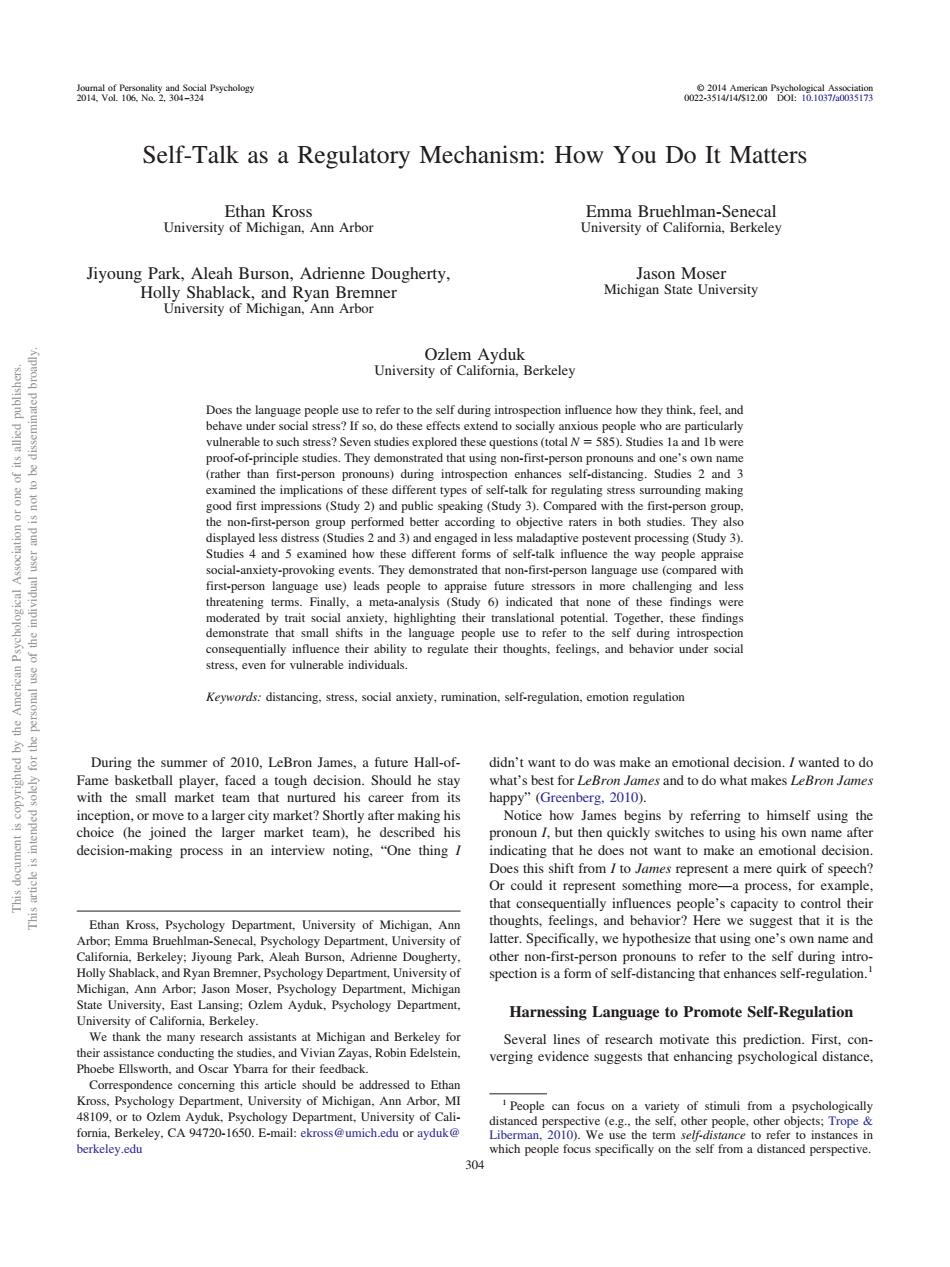正在加载图片...

4 Vot 0 N 2109700173 Self-Talk as a Regulatory Mechanism:How You Do It Matters Jiyoung Park,Aleah Burson,Adrienne Dougherty. HolxshablackamgRaBeomncr Mic niveraty Uaen把handky i They demonsraed tht )h a m () e the .ruminaiosef-reuaionmtoution didn' F decision-making process in an interview noting."One thing that latter.Specifically.we hypothesize that using one's own name and Harnessing Language to Promote Self-Regulation berkeley.edu 304Self-Talk as a Regulatory Mechanism: How You Do It Matters Ethan Kross University of Michigan, Ann Arbor Emma Bruehlman-Senecal University of California, Berkeley Jiyoung Park, Aleah Burson, Adrienne Dougherty, Holly Shablack, and Ryan Bremner University of Michigan, Ann Arbor Jason Moser Michigan State University Ozlem Ayduk University of California, Berkeley Does the language people use to refer to the self during introspection influence how they think, feel, and behave under social stress? If so, do these effects extend to socially anxious people who are particularly vulnerable to such stress? Seven studies explored these questions (total N 585). Studies 1a and 1b were proof-of-principle studies. They demonstrated that using non-first-person pronouns and one’s own name (rather than first-person pronouns) during introspection enhances self-distancing. Studies 2 and 3 examined the implications of these different types of self-talk for regulating stress surrounding making good first impressions (Study 2) and public speaking (Study 3). Compared with the first-person group, the non-first-person group performed better according to objective raters in both studies. They also displayed less distress (Studies 2 and 3) and engaged in less maladaptive postevent processing (Study 3). Studies 4 and 5 examined how these different forms of self-talk influence the way people appraise social-anxiety-provoking events. They demonstrated that non-first-person language use (compared with first-person language use) leads people to appraise future stressors in more challenging and less threatening terms. Finally, a meta-analysis (Study 6) indicated that none of these findings were moderated by trait social anxiety, highlighting their translational potential. Together, these findings demonstrate that small shifts in the language people use to refer to the self during introspection consequentially influence their ability to regulate their thoughts, feelings, and behavior under social stress, even for vulnerable individuals. Keywords: distancing, stress, social anxiety, rumination, self-regulation, emotion regulation During the summer of 2010, LeBron James, a future Hall-ofFame basketball player, faced a tough decision. Should he stay with the small market team that nurtured his career from its inception, or move to a larger city market? Shortly after making his choice (he joined the larger market team), he described his decision-making process in an interview noting, “One thing I didn’t want to do was make an emotional decision. I wanted to do what’s best for LeBron James and to do what makes LeBron James happy” (Greenberg, 2010). Notice how James begins by referring to himself using the pronoun I, but then quickly switches to using his own name after indicating that he does not want to make an emotional decision. Does this shift from I to James represent a mere quirk of speech? Or could it represent something more—a process, for example, that consequentially influences people’s capacity to control their thoughts, feelings, and behavior? Here we suggest that it is the latter. Specifically, we hypothesize that using one’s own name and other non-first-person pronouns to refer to the self during introspection is a form of self-distancing that enhances self-regulation.1 Harnessing Language to Promote Self-Regulation Several lines of research motivate this prediction. First, converging evidence suggests that enhancing psychological distance, 1 People can focus on a variety of stimuli from a psychologically distanced perspective (e.g., the self, other people, other objects; Trope & Liberman, 2010). We use the term self-distance to refer to instances in which people focus specifically on the self from a distanced perspective. Ethan Kross, Psychology Department, University of Michigan, Ann Arbor; Emma Bruehlman-Senecal, Psychology Department, University of California, Berkeley; Jiyoung Park, Aleah Burson, Adrienne Dougherty, Holly Shablack, and Ryan Bremner, Psychology Department, University of Michigan, Ann Arbor; Jason Moser, Psychology Department, Michigan State University, East Lansing; Ozlem Ayduk, Psychology Department, University of California, Berkeley. We thank the many research assistants at Michigan and Berkeley for their assistance conducting the studies, and Vivian Zayas, Robin Edelstein, Phoebe Ellsworth, and Oscar Ybarra for their feedback. Correspondence concerning this article should be addressed to Ethan Kross, Psychology Department, University of Michigan, Ann Arbor, MI 48109, or to Ozlem Ayduk, Psychology Department, University of California, Berkeley, CA 94720-1650. E-mail: ekross@umich.edu or ayduk@ berkeley.edu This document is copyrighted by the American Psychological Association or one of its allied publishers. This article is intended solely for the personal use of the individual user and is not to be disseminated broadly. Journal of Personality and Social Psychology © 2014 American Psychological Association 2014, Vol. 106, No. 2, 304 –324 0022-3514/14/$12.00 DOI: 10.1037/a0035173 304